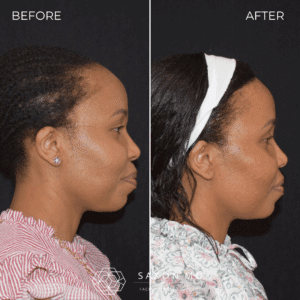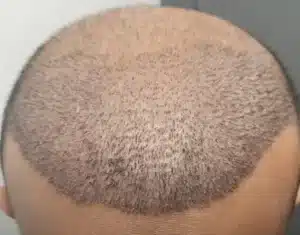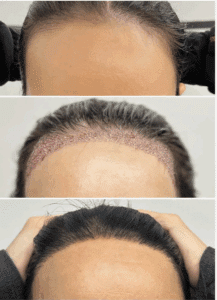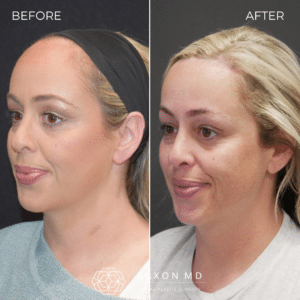Forehead Reduction vs Hair Transplant
When you look in the mirror, your hairline is one of the first things that defines the balance of your face. A high forehead or receding hairline can make your features appear longer, older, or less harmonious. For many people — especially women and men with early hairline changes — improving the position or density of the hairline can dramatically change how youthful and balanced the face looks.
If you’ve been researching ways to achieve this, you’ve likely come across two main procedures: forehead reduction (also called hairline lowering) and hair transplant surgery. Both can enhance the hairline, but they do so in completely different ways. Understanding their differences — including how they’re performed, what recovery is like, and which is better for your anatomy and goals — is essential before deciding which path to take.
In this guide, we’ll break down everything you need to know about forehead reduction vs hair transplant, including how to know which one is right for you.
Why the Hairline Matters
Your hairline frames your face — it defines your proportions and subtly affects how others perceive your features. A high or receding hairline can make the forehead look longer and the eyes appear smaller. For women, this sometimes gives a more masculine look. For men, a receding hairline can signal aging before any other feature changes.
The ideal hairline height varies from person to person, but generally:
The vertical distance from the eyebrows to the hairline should be about one-third of the face length.
In women, a hairline that sits around 5–6 cm above the eyebrows tends to look most natural.
In men, a slightly higher and more M-shaped hairline often appears masculine and proportional.
When the forehead height exceeds these proportions or the hairline recedes over time, two main surgical options can restore balance: forehead reduction and hair transplant.

What Is Forehead Reduction Surgery?
Forehead reduction surgery, also called hairline lowering, is a facial procedure that physically moves the hairline forward by removing excess forehead skin and advancing the scalp.
It’s most commonly chosen by:
Women with naturally high hairlines
Men or women who want immediate, permanent reduction in forehead height
How the Procedure Works
The procedure is performed under general anesthesia. Here’s what happens step by step:
Incision design: Dr. Saxon carefully marks the natural contour of the existing hairline. An irregular incision is made along the hairline to mimic the pattern of natural hair growth, which helps camouflage the scar.
Elevation and release of ligaments: The forehead and scalp skin is lifted, and ligaments limiting scalp movement are carefully released. The scalp is then advanced forward — usually between 1.5 to 3 centimeters.
Skin removal and closure: Excess skin is removed, and the incision is closed precisely to ensure fine scarring.
The result is an immediate reduction in forehead height, with the hairline sitting lower on the face.

What Are the Benefits of Forehead Reduction?
1. Immediate, Predictable Results
Unlike hair transplant surgery — where new hair growth takes months to appear — forehead reduction provides instant change. The hairline is physically advanced, so you can see your new proportions as soon as the swelling subsides.
2. Long-Lasting Outcome
Once healed, the new hairline position is permanent. You won’t need repeat sessions or maintenance procedures to keep it in place.
3. Natural Hair Density
The natural hairline has very fine hairs. Forehead reduction surgery brings the natural hairline forward, allowing these fine wispy hairs to grow through the incision over time. This provides a more natural result compared to hairs grafts since the transplanted hairs are thicker and the overall density of the new hairline is not the same as the surrounding hair.
4. Refined, Natural Scar Placement
Modern techniques place the incision in an irregular pattern that blends with natural hair growth. Hair follicles are often preserved at the incision edges, allowing hair to grow through the scar over time, making it nearly invisible.
5. One Procedure Instead of Many
Because the result is achieved surgically, patients typically need just one procedure to reach their desired hairline position — unlike hair transplant surgery, which can require multiple sessions for adequate density.
What Is a Hair Transplant?
A hair transplant — sometimes referred to as hair grafting — is a surgical procedure that redistributes hair from areas with dense growth (typically the back and sides of the scalp) to areas with thinning or recession.
It’s most commonly used to:
Treat male or female pattern hair loss
Fill in receding temples
Create a natural hairline in patients who have lost hair due to aging or hormones
Refine scars or add density after a previous procedure
Two Main Techniques
Follicular Unit Transplantation (FUT):
A strip of scalp is removed from the donor area, and hair follicles are microscopically dissected and transplanted. This leaves a fine linear scar that is hidden under surrounding hair.Follicular Unit Extraction (FUE):
Individual follicles are harvested directly with a tiny punch device and transplanted one by one. This method leaves small dot scars instead of a line, making it preferable for patients who wear short hair.

Benefits of Hair Transplant Surgery
1. Minimally Invasive
Compared to forehead reduction, hair transplant surgery doesn’t alter the position of the scalp or forehead skin. It’s performed under local anesthesia, and patients can usually resume daily activities within a few days.
2. Versatility
Hair transplants can treat not only the hairline but also the crown, temples, beard, and even eyebrows. They’re a great option for addressing overall thinning.
3. No Forehead Incision
There’s no need for an incision along the hairline, which eliminates the risk of a visible scar at the front of the scalp.
Drawbacks for Hair Transplants
-Delayed Results
Hair transplant results take time. After surgery, most of the transplanted hairs shed within a few weeks before new growth starts around month three or four. Full results can take up to a year.
-Multiple Sessions May Be Needed
Achieving a dense, natural-looking hairline often requires more than one session. A single round of grafts may create a softer, less dense look that needs refinement later.
-Can Look Very Unnatural
It takes a very skilled hair transplant surgeon to get natural-looking results when lowering the hairline. Many think that their results look to uniform, and the hair looks too thick compared to a natural hairline.
-Cost
Hair transplants are charged per graft, so costs vary widely. Large areas of thinning may require thousands of grafts, making the procedure more expensive than forehead reduction in some cases.
-Limited Donor Supply
The success of a transplant depends on having healthy donor hair. Patients with generalized thinning or poor donor density may not have enough follicles for an optimal result.
-Ongoing Hair Loss
If you’re genetically prone to further recession, future transplants may be needed to maintain a natural appearance. The transplanted hair remains, but the surrounding native hair may continue to thin.

Forehead Reduction vs Hair Transplant
| Category | Forehead Reduction (Hairline Lowering) | Hair Transplant |
|---|---|---|
| Goal | Lowers the position of the hairline | Adds density or fills in receding areas |
| Result Timeline | Immediate | Gradual (6–12 months) |
| Scarring | Fine scar along hairline | Small dot scars (FUE) or linear scar (FUT) |
| Downtime | 1–2 weeks | 3–5 days |
| Ideal Candidates | Women with a high forehead, stable hair growth | Men or women with thinning or receding hairline |
| Longevity | Permanent | Permanent grafts, but may need touch-ups |
| Cost | Fixed surgical fee | Priced per graft, varies by density |
| Anesthesia | General anesthesia | Local anesthesia |
| Flexibility | Cannot be reversed | Can be repeated or adjusted later |
Which Procedure Is Better for You?
Choose Forehead Reduction If:
You have a naturally high or elongated forehead.
You have dense, stable hair with no ongoing thinning.
You want an immediate, measurable change in forehead height.
You prefer a one-time, permanent solution with predictable results.
Forehead reduction is particularly ideal for women and anyone whose main concern is forehead height, not hair density.
Choose Hair Transplant If:
You’re experiencing hair loss or thinning that’s likely to progress.
You want to gradually rebuild or reshape your hairline.
You’d rather avoid a forehead incision.
You have a strong donor area and want flexibility for future treatments.
Hair transplantation is the best option for men with male-pattern baldness or women with diffuse thinning.

Can the Two Procedures Be Combined?
Yes — in fact, combining forehead reduction and hair transplant often delivers the most natural and refined results.
A common approach is to first advance the hairline surgically through forehead reduction. Then, several months later, a small hair transplant session is performed to:
Camouflage the incision line
Add density at the very front of the hairline
Perfect the shape and texture of the new hairline
Because far fewer grafts are needed, this combination is often more cost-effective than attempting to lower the hairline entirely through grafting alone.
Cost Comparison
While costs vary by region and provider, here’s a general range:
Forehead Reduction Surgery: $7,000–$10,000
Hair Transplant (FUE or FUT): $3–$6 per graft, totaling $8,000–$15,000+ depending on the number of grafts
If you have a high forehead but stable hair growth, forehead reduction is often less expensive overall, since it usually requires just one surgery. However, if you’re prone to ongoing hair loss, a transplant may save you from a visible scar later.

Finding the Right Solution for You
When comparing forehead reduction vs hair transplant, the best option depends entirely on what’s causing your concern and what kind of result you want.
If your main issue is a high forehead, forehead reduction provides immediate, lasting improvement in facial balance.
If your concern is thinning or receding hair, a hair transplant is the better option for restoring density and fullness.
And if you want the most refined result possible, combining both techniques can offer the best of both worlds.
During a consultation, Dr. Saxon can evaluate your hairline shape, scalp laxity, and hair growth pattern to create a personalized plan that fits your goals.
You May Also Like:
- Forehead Reduction Surgery Cost: Everything You Need To Know Before You Book
- The Best Surgical Options For A Big Forehead
- Forehead Reduction Surgery Gone Wrong: Cautionary Tales and Prevention Strategies
- How to Camouflage Your Hairline Lowering Incision After Surgery
- Hairline Lowering Before and After Gallery